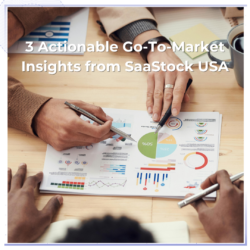With AI reshaping the B2B SaaS sales process, are Sales Development Representatives (SDRs) even necessary in 2025?
Despite what you might read, it’s a resounding yes.
As closing SaaS deals gets harder – from increased competition and heightened customer expectations to longer sales cycles and smaller budgets – the need for best-in-class SDRs (boosted by AI) gets greater.
In this article, we’ll draw on insights from our SaaS Revolution Show podcast, SaaStock conferences, and sales leader interviews to show you:
- The role SDRs perform in 2025
- How to build your SDR team in the AI era
- How to recognise and nurture best-in-class SDRs
- 5 ways to set up your SDR team for success
- How to boost SDR performance with AI tools
- The metrics to track SDR performance
What is the role of an SDR in 2025?
Despite AI-driven changes to the sales process, an SDR’s core job remains the same: to identify prospects and build the pipeline.
SaaS SDRs are responsible for qualifying leads, determining the most viable sales opportunities, making the initial approach and then passing on the prospect to an Account Executive to close the deal.
As such, SDRs in 2025 must have the skills to:
- Pinpoint people or companies who match your ideal customer profile (ICP).
- Use AI tools to successfully engage with thousands of inbound and outbound prospects.
- Quickly understand prospects’ challenges and log these pain points in your CRM.
- Tailor information about your product or service to prospects during initial outreach.
- Determine which deals have the most chance of closing.
How to build your SDR team in the AI era
Use AI agents to support SDRs
AI agents are not replacing SDRs – they’re enhancing SDRs’ impact.
At Chili Piper, AI agents support SDRs with pipeline health, territory planning, lead qualification and CRM upkeep, freeing up SDRs to focus where they add the most value: the human touch.
“All of the things a typical SDR does are done by agents,” says co-founder Alina Vandenberghe. SDRs then own the last mile and personalise the message, ensuring that each prospect interaction is meaningful.
With this approach, Chili Piper’s 17 outbound SDRs booked 500 meetings and achieved 160% of their quota in Q1 2025.
Automate manual tasks
AI and automation are not always the same thing – but both can enhance SDR efficiency.
At Go Nimbly, for example, CEO Jen Igartua notes that AI automation not only takes tasks off an SDRs plate, but in some cases, completes these tasks to a better standard.
“Not only can I automate my research, but I can make my research better and deeper. I can have better insights and translate them into smarter thoughts, so there’s definitely that upleveling that AI can do.”
Meanwhile, offline engagement platform Postal achieved 5,000%+ revenue growth between 2022-2024 with only one SDR, who filtered inbound leads generated by AI technology and sent the most qualified opportunities to the AEs.
Choose internal SDRs vs. agencies
Some B2B SaaS companies prefer to use an agency for SDR sales, but AI has swung the dial firmly in favour of hiring SDRs in-house.
Farlan Dowell, former VP of Sales at Cleanshelf (now LeanIX), believes that hiring in-house allows you to hand-pick best-in-class SDRs. You don’t need to rely on the agency’s team or spend time getting the agency up-to-speed about your customers and prospects.
What’s more, with AI making it easier to build – and constantly refresh – your own prospect lists, internal SDRs can be more effective than agency SDRs.
How to hire and nurture best-in-class SDRs
Choose the right sales skills for your stage
While a great SDR looks different at each growth stage, there are some fundamental skills that all SDRs should have. According to Alina Vandenberghe, great SDRs:
- Have emotional IQ and create trust through their comms.
- Are great storytellers and speak CFO language.
- Teach buyers new things about their business.
- Are resilient and self-driven.
- Build consensus.
These SDR skills can be honed post-hire too. For instance, managers can improve SDRs storytelling and trust-building through coaching, and teach SDRs to make best use of AI agents and tools.
Look for core SDR characteristics
SDRs are responsible for sourcing and landing meetings. To do this successfully, they need to really understand your ICP, the challenges they face and how your product solves these challenges better than the competition.
As such, best-in-class SDRs should be:
- Ruthless decision-makers. Top SDRs are methodical, organised, and don’t let outside distractions get in the way of their overall goal. They don’t jump on every shiny object, but stick to their ICP and designated role in the sales process.
- Thoughtful listeners. Great SDRs listen carefully to customer concerns, ask good questions and address core objections quickly. They get meetings by nailing the prospect’s key pain point so precisely that they feel compelled to learn more.
- Competitive hustlers. Excellent SDRs have something to prove and love to win. They have a chip on their shoulder, are driven by monetary goals and enjoy using their intellect to convert names on a list to meetings in the calendar.
5 ways to set up your SDR team for success
1. Go on ‘rep rides’ to find efficiency opportunities
SDR efficiency often boils down to automation, so Jen Igartua recommends sitting with your reps for half an hour to understand their process, find areas that are painful and pinpoint automation opportunities.
“How they pull lists, how they add people on LinkedIn, and how they prepare for meetings are all opportunities for automation.”
2. Encourage SDRs to customise the sales experience
According to Jake Dunlap, CEO of Skaled, you’re more likely to close from 20 personalised interactions than you are from 500 cold calls. So instead of treating all prospects in the same way, task your SDRs to meet customers where they’re at and how they work.
For example, if they’ve self-educated on your product and reached out to you, you shouldn’t give them the same demo as someone who you cold called.
3. Nail your ICP
SDRs should only sell to your ideal customer, so you need to outline a specific ICP that SDRs can target with precision. This will likely start out as job titles, but soon develop into characteristics and responsibilities as SDRs get more experience.
Secondly, task your SDRs to use ICP language. According to Kevin Dorsey, Winning by Design’s revenue guru, SDRs should not only find out your ICP’s problems, but use prospects’ own language to show how your solution solves that problem.
4. Don’t complicate the bonus plan
To keep your SDRs focused, make your sales compensation plan extremely simple.
For Farlan Dowell, the best approach is a flat fee per sales qualified opportunity (i.e. ICP + meeting). There’s no guessing about the ICP (because sales leaders define it) nor complicated bonus structures that distract SDRs.
5. Couple training with hands-on experience
Get an SDR’s feet wet with a project and then focus your training around any questions or confusion that comes up.
For example, tell your new SDR to find 50 leads and then discuss who they found. As they gain experience, they’ll hit walls, have questions, and adapt.
How to boost SDR performance with AI tools
When implemented successfully, AI tools can take on 80-90% of some SDR tasks, including messaging (i.e. tone improvements for reps) and top-of-the-funnel sourcing. But with so many AI tools available, you need to think about where your SDRs are inefficient and then implement the appropriate AI tools. Here are five areas to consider.
Pre-meeting research
At Go Nimbly, they integrate Clay with their CRM, so SDRs can simply press a button and instantly see a paragraph with all the key information they need for the sales call. This could include:
- Data from the target companies’ pricing page.
- Summaries of the company CEO’s last three LinkedIn posts.
- The last three companies the person worked at.
Post-meeting summaries
Human interaction is an SDR’s most valuable asset, so free up SDRs during sales calls to focus entirely on the customer. By using the likes of Fathom, you can generate instant summaries of sales calls, including key customer pain points and actions, without SDRs needing to make notes.
Intuitive insights
At Skaled, they build AI assistants to handle tasks including call prep, prospect researching, onboarding, and competitive intelligence. These AI insights then prompt the human, not the other way around. The result? Sales reps save three to four hours each week.
Quicker responses
SDR outreach must be captivating and prompt. By using email AI tools like Superhuman and Fyxer.AI to draft email responses based on previous SDR-prospect interactions, your SDRs not only respond to inbound queries faster, but in a more customised way.
Lead scoring and prioritisation
AI-driven scoring models can help SDRs focus on the leads most likely to convert. For instance, Pocus is a PLG-focused lead scoring tool that helps sales teams identify the best product-qualified leads (PQLs) while Gong automates deal tracking and conversation analysis to surface hidden sales insights.
What metrics best measure SDR performance?
So, you’ve hired your SDRs, set up the team and integrated a stack of AI tools – how do you know it’s working?
Traditionally, SDR metrics were split into two core areas:
- Activity metrics – i.e. # calls per per week, # meetings booked, # emails sent.
- Outcome metrics – i.e. # qualified leads, % pipeline generated, revenue generated.
However, Jake Dunlap thinks B2B SaaS companies should move away from volume as the leading indicator of SDR success and focus on more high quality sales activity.
As such, you should also take into account:
- Efficiency metrics – i.e. lead-to-opportunity conversion (% of emails/calls to meetings)
- Quality metrics – i.e. the value of each interaction, referrals.
Stay up-to-date
Whether it’s new AI sales tools or fresh SDR management approaches, the sales development part of the SaaS sales process is undergoing a fundamental transformation.
To stay up-to-date with all the latest insights, sign up for our fortnightly SaaStock Blueprint newsletter.
Recommended media:
- B2B SaaS sales: Using AI to close more deals and boost productivity with Martin Garvey (Director of Enterprise Sales, Gong)
- GTM efficiency, AI, and the future of SaaS sales with Jen Igartua (Go Nimbly)
- SaaS sales in 2025: How AI has changed the sales function (and what good looks like now) with Postal CRO, Patricia DuChene





